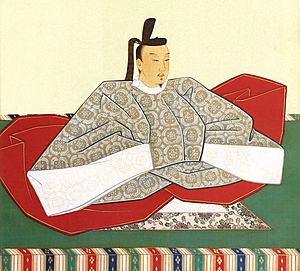Emperor Go-Komatsu facts for kids
Quick facts for kids Emperor Go-Komatsu後小松天皇 |
|||||
|---|---|---|---|---|---|
 |
|||||
| Emperor of Japan | |||||
| Reign | 19 November 1392 – 5 October 1412 | ||||
| Predecessor | Go-Kameyama | ||||
| Successor | Shōkō | ||||
| Shōgun | Ashikaga Yoshimitsu Ashikaga Yoshimochi |
||||
| 6th Northern Emperor | |||||
| Reign | 24 May 1382 – 19 November 1392 | ||||
| Coronation | 31 January 1383 | ||||
| Predecessor | Go-En'yū | ||||
| Successor | None | ||||
| Born | Motohito (幹仁) 1 August 1377 |
||||
| Died | 1 December 1433 (aged 56) | ||||
| Burial | Fukakusa no kita no Misasagi (深草北陵) (Kyoto) | ||||
| Issue more... |
Ikkyū Sōjun Emperor Shōkō |
||||
|
|||||
| House | Yamato | ||||
| Father | Emperor Go-En'yū | ||||
| Mother | Sanjō Itsuko | ||||
| Signature |  |
||||
Emperor Go-Komatsu (後小松天皇, Go-Komatsu-tennō, 1 August 1377 – 1 December 1433) was the 100th emperor of Japan. He was also the sixth and last Northern Emperor during a time when Japan had two rival imperial courts.
He was first known as the Northern "pretender" (someone claiming to be the rightful ruler) from 1382 to 1392. However, when Emperor Go-Kameyama of the Southern Court gave up his throne in 1392, Go-Komatsu became the official 100th Emperor. This event brought an end to the long period of two rival courts, known as the Nanboku-chō period.
An agreement was made to share the throne between the Northern and Southern families every ten years. But Emperor Go-Komatsu did not follow this plan. He ruled for 20 years, until 1412. After that, his own son became emperor, not someone from the Southern Court. Because of this, all future emperors came from the Northern Court line. Today, the Japanese Imperial Family is descended from these Northern Court emperors.
The name "Go-Komatsu" means "later Emperor Komatsu." He was named after an earlier emperor, Emperor Kōkō, who was also called "the Emperor of Komatsu." The word go- often means "later" or "second."
Contents
Family and Early Life
Before he became emperor, his personal name was Motohito (幹仁).
Emperor Go-Komatsu was the first son of Emperor Go-En'yū. His mother was Tsūyōmonin no Itsuko, whose father was Sanjō Kimitada.
He had several children:
- With his main consort, Hinonishi Motoko:
- First son: Imperial Prince Mihito (1401–1428), who later became Emperor Shōkō.
- Second son: Prince Ogawa (1404–1425), who was the crown prince for Emperor Shōkō.
- First daughter: Princess Riei (1406–1447).
- With an unknown lady-in-waiting from the Southern Court:
- Ikkyū Sōjun, a famous Zen Buddhist monk.
Go-Komatsu was named after Emperor Kōkō because both emperors helped bring the throne back to their own family lines. Go-Komatsu did this by defeating his Southern Court rivals. Emperor Kōkō did it by becoming emperor after his elder brother's grandson, Emperor Yōzei.
Key Events of His Reign
Go-Komatsu grew up during the difficult Nanboku-chō period. This was a time when Japan had two competing imperial courts, the Northern and Southern Courts. He became the Northern Emperor after his father, Emperor Go-En'yū, stepped down. His father continued to guide him as a "Cloistered Emperor," meaning he was still powerful behind the scenes.
In 1392, a powerful military leader named Ashikaga Yoshimitsu helped bring the two courts together. He convinced Emperor Go-Kameyama of the Southern Court to give the Imperial Regalia (sacred treasures that symbolize the emperor's power) to Go-Komatsu. This meant Go-Komatsu officially became the true emperor of Japan.
The peace agreement stated that the Northern and Southern Courts would take turns ruling. However, when Emperor Go-Komatsu stepped down in 1412, he broke this promise. Instead of a Southern Court prince, his own son, Emperor Shōkō, became the next emperor. From then on, all emperors came from the Northern Court line.
For a long time, the Northern Court emperors were seen as the only legitimate ones. But in 1911, historians decided that the Southern Court was actually the legitimate one for a while. This was because they held the three sacred treasures. So, for the first 10 years of his reign, Emperor Go-Komatsu is now considered to have been a "pretender" by some historians.
Emperor Go-Komatsu is buried with other emperors at an imperial tomb in Kyoto. It is called Fukakusa no kita no misasagi.
Eras During His Rule
The years of Emperor Go-Komatsu's reign are known by different era names (called nengō). This is because there were two courts at first.
Northern Court Eras (considered legitimate by modern historians for some time)
Southern Court Eras (considered legitimate by modern historians for some time)
Unified Court Eras (after 1392)
Southern Court Emperors
During the time of the two courts, these were the emperors of the Southern Court:
- Chōkei
- Go-Kameyama
See also
 In Spanish: Go-Komatsu Tennō para niños
In Spanish: Go-Komatsu Tennō para niños

